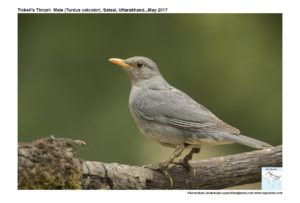Tickell’s Thrush

Tickell’s Thrush Turdus unicolor
Etymology:
- Turdus : Latin word for Thrush
- Unicolor : Latin word uni– single-; color-colour { Plain}
Vernacular Names:Hindi: Desipawai, Kash: Kostur, Kao kumr, Ben: Machasah, Mar: Tickel cha Kastur
Distribution in India: Summer resident of Himalayas and Winter visitor of Lower Himalayas, Central and EastIndia.
Description:
Size of 20-21 cm. The male is plain ashy-grey, slightly paler below, with faint blackish lores, slight white streaking on throat, white mid-belly to undertail-coverts; yellow bill, eyering and legs. The female is pale olive-brown above, with greyish-white submoustachial and chin divided by dark brown narrow malar, latter ending in bunches of spots forming narrow necklace on buff breast; buff flanks, white mid-belly to vent; bill and legs are yellowish-brown. The juvenile is brown above, with vague buffy supercilium and buffy streaks from crown to scapulars, double orange-spotted wingbars, malar pattern as female but with spotting denser and continuing down breast and flanks, with orange flush on flanks, shading to buffy-white on belly to vent. The immature is like female, but buff tips on greater coverts form wingbar, malar more diffuse, no spotting on neck.
Habitat: It breeds in open broadleaf montane forest with grassy or bare substrate, including mixed deciduous and forest, open deodar forest, willow groves, mixed terraced fields with deciduous trees and scattered bushes, gardens, lawns and orchard groves. Found at 1200 to 2400 m. It winters in deciduous forest edge, groves and well-wooded areas in lower foothills and adjacent plains.
Food habits: It eats earthworms, insects and fruit, including orchard windfalls. It forages on bare ground but also in short-herb substrates such as lawns; uses typical thrush technique of short hopping runs and pauses. In winter it isfound sometimes in loose groups.
Breeding habits: They breed in Apr–Aug in India. The nest is a deep cup, sometimes tidy, sometimes straggly, made of fibres, dry or green moss, ferns, roots, dry stems and leaves, sometimes held with mud, lined with fine rootlets or horsehair, placed up in tree fork or against trunk, sometimes in bush or in cavity in bank. They lay a clutch of 3–5 eggs. The incubation period is 13–14 days.